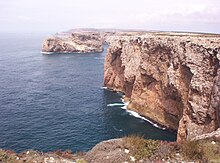Cliff coast
The cliff coast , including demolition coast or Abrasionsküste called, refers to a coastal form , by the action of the ocean surf on a cliff is designed.
etymology
It is a Romanesque loan word that has its origin in the Latin forms clivus / clevus (slope). Through its Middle Low German forms, the name is etymologically related to Klippe and the Kliff names of the inland.
education

The constant work of the surf, the abrasion , creates the cliff on coasts where the mainland dips below the surface of the sea at a relatively steep angle. The slope is constantly being removed here. The ocean waves crash against the foot of the cliff, where they hollow out the cliff due to their persistent abrasive action. This cavity is known as the surf cave. The cliff above the hollow is less affected and therefore forms an increasingly pronounced overhang until its own weight causes it to slide off. The slipped material comes to rest in front of the cliff and is further processed and / or removed by the waves. All these processes move the coast back inland. The speed at which this happens depends in particular on the strength of the surf, the height of the cliff, the number of storm surges and the resistance to erosion of the material from which the cliff is made. The Mecklenburg coast shifts by approx. 25 cm, but the chalk cliff on the canal coast of southern England only shifts inland by 0.5 cm per year. Cliff coasts are formed in loose material, such as at the Roter Kliff on Sylt , but can just as well arise in solid rock as with the red sandstone cliffs of Helgoland . However, there are certain differences between the former and the latter in terms of the shape of the coast.
Special features of cliff coasts
On rocky cliffs made of relatively erosion-resistant material such as sandstone, limestone or granite, the so-called abrasion plate or rock churn forms in front of the cliff . It represents the foot of the cliff preserved below the waterline. On coasts with pronounced tides , it regularly falls dry and forms a rocky floodplain . In the event of a tectonic uplift of the coast, these abrasion surfaces can rise up as coastal terraces, at whose altitude relative to sea level the amount of uplift can be read off, taking into account the eustatic sea level fluctuations . On cliff coasts, the steep banks of which are made of loose material such as sand or clay, or of relatively easily erodible rock such as mudstone, no abrasion platform is formed, but a beach.
If the surf hits a promontory on a relatively erosion-resistant cliff coast, the bending of the waves creates fillets on both sides of the protrusion. This process can create arched rocks . If the arch collapses, a residual rock in front of the actual cliff remains, which is called a breakwater pillar . The most famous example in Germany is Lange Anna on Heligoland .
In addition, in contrast to coasts with cliffs made of loose material, the mechanical abrasion effect of the surf is not the only important mechanism that leads to the coastline moving inland. The general mechanisms of weathering are almost as important there .
Living and dead cliffs
A living cliff is a section of a cliff coast that is actively eroded and set back by the sea. A dead cliff (calm cliff ), on the other hand, is only reached by very high sea waves or storm surges and is therefore primarily only subject to weathering . Dead cliffs can arise when the surf platform in front of the cliff becomes so wide (around 1000 m) that the wave energy is no longer sufficient to effectively erode the cliff by stepping backwards . Tectonic uplifts or a drop in sea level can also inactivate a cliff. A clear indication of the low level of activity on the dead cliff is, for example, a cover of vegetation that can only develop in the cliff area thanks to the subsiding surf.
Well-known coastlines in Germany with a living cliff are the Rote Kliff in Kampen on Sylt or the chalk cliffs on Jasmund . The Königsstuhl on Rügen is an example of a dead cliff. More can be found in the areas of today's wadden coast of the North Sea several kilometers inland. These show the former coastline, from which the sea receded further and further as the North Sea level dropped.
Web links
Individual evidence
- ↑ Monika Buchmüller-Pfaff: Names in the borderland - methods, aspects and objectives in the study of the Lorraine-Saarland toponomics. Francia 18/1, 1991 (Francia-Online: Institut historique allemand de Paris - German Historical Institute Paris : online resource ).
- ↑ Max Pfister: Old Romanesque relics in the eastern and southern Galloromania, in the Rhenish dialects, in the Alpine region and in northern Italy. In: Sieglinde Heinz, Ulrich Wandruszka (ed.): Facts and theories: Contribution to the roman. u. general linguistic science Festschr. for Helmut Stimm on his 65th birthday. Tübingen 1982, ISBN 3-87808-936-8 , pp. 219-230.
- ^ Hjalmar Falk, Alf Torp: Vocabulary of the Germanic language unit. 5th, unchanged. Ed., Unchanged. Reprint d. 4th edition. from 1909, Göttingen 1979, ISBN 3-525-26405-4 .
- ^ A b Herbert Louis and Klaus Fischer: Allgemeine Geomorphologie , de Gruyter, 4th ed., Berlin 1979, pp. 532-537.
- ↑ Hans Georg Wunderlich: Introduction to Geology. Volume I: Exogenous Dynamics. Bibliographical Institute Mannheim / Vienna / Zurich, BI-Wissenschaftsverlag, Mannheim 1968, p. 116.
- ↑ Zepp Harald: Geomorphology . 5th edition. UTB, Paderborn 2011, ISBN 978-3-8252-3593-2 , p. 272 .

